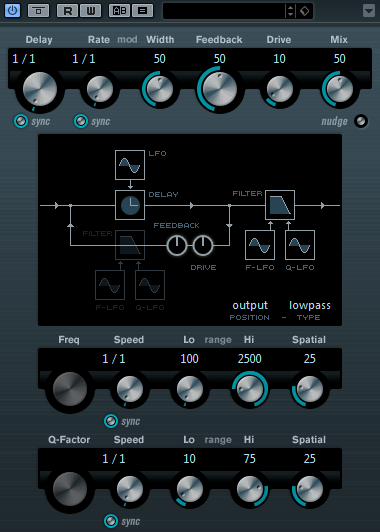ModMachine
ModMachine combines delay modulation and filter frequency/resonance modulation and can provide many interesting modulation effects. It also features a Drive parameter for distortion effects.
|
Cubase LE |
Cubase AI |
Cubase Elements |
Cubase Artist |
Cubase Pro |
Nuendo |
|
|---|---|---|---|---|---|---|
|
Included with |
– |
– |
– |
– |
X |
X |

- Delay
If tempo sync is activated, this sets the base note value for the delay. If tempo sync is deactivated, the delay time can be set freely in milliseconds.
- Delay – Sync
Activates/Deactivates tempo sync for the Delay parameter.
- Rate
If tempo sync is activated, this is where you specify the base note value for tempo-syncing the effect (1/1 to 1/32, straight, triplet, or dotted).
If tempo sync is deactivated, the modulation speed can be set freely with the Rate knob.
- Rate – Sync
Activates/Deactivates tempo sync for the Rate parameter.
- Width
Sets the amount of delay modulation. This allows you to create a vibrato or chorus-like effect.
- Feedback
Sets the number of repeats for the delay.
- Drive
Adds distortion to the feedback loop. The longer the feedback, the more the delay repeats are distorted over time.
- Mix
Sets the level balance between the dry signal and the wet signal. If the effect is used as a send effect, set this parameter to the maximum value as you can control the dry/effect balance with the send.
- Nudge
Clicking this button once momentarily speeds up the audio coming into the plug-in, simulating the nudge command of analog tape machines.
- Signal path graphic and Filter position
The filter can either be placed in the feedback loop of the delay or in the output path of the effect (after the Drive and Feedback parameters). To switch between the loop and output positions, click in the Filter section displayed in the graphic or click on the Position field at the bottom right of the graphic.
- Filter type (in graphic display)
Allows you to select a filter type. You can choose between a low-pass, band-pass, and high-pass filter.
Filter Frequency LFO Modulation
- Freq
Sets the cutoff frequency for the filter. It is only available if tempo sync for the Speed parameter is deactivated and the parameter is set to 0.
- Speed
Sets the speed of the filter frequency LFO modulation. If tempo sync is activated, this parameter sets the base note value for synchronizing the modulation to the tempo of the host application.
If tempo sync is deactivated, the speed can be set freely with the Speed knob.
- Speed – Sync
Activates/Deactivates tempo sync for the Speed parameter.
- Range Lo/Hi
Set the range of the filter frequency modulation. Both positive (for example, Lo set to 50 and Hi set to 10000) and negative (for example, Lo set to 5000 and Hi set to 500) ranges can be set. If tempo sync is off and Speed is set to zero, these parameters are inactive and the filter frequency is controlled by the Freq parameter instead.
- Spatial
Introduces an offset between the channels to create a stereo panorama effect for the filter frequency modulation. Turn clockwise for a more pronounced stereo effect.
Filter Resonance LFO Modulation
- Q-Factor
Sets the resonance of the filter. It is only available if filter resonance LFO tempo sync is deactivated and the Speed parameter is set to 0. If tempo sync is activated, the resonance is controlled by the Speed and Range parameters.
- Speed
Sets the speed of the filter resonance LFO modulation. If tempo sync is activated, this parameter sets the base note value for tempo syncing the modulation.
If tempo sync is deactivated, the speed can be set freely with the Speed knob.
- Speed – Sync
Activates/Deactivates tempo sync for the Speed parameter.
- Range Lo/Hi
Set the range of the filter resonance modulation. Both positive (for example, Lo set to 50 and Hi set to 100) and negative (for example, Lo set to 100 and Hi set to 50) ranges can be set. If tempo sync is deactivated and Speed is set to zero, these parameters are inactive and the filter resonance is controlled by the Q-Factor parameter instead.
- Spatial
Introduces an offset between the channels to create a stereo panorama effect for the filter resonance modulation. Turn clockwise for a more pronounced stereo effect.